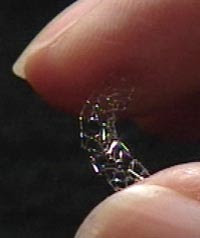Serruys W Patrick at el. The New England Journal Of Medicine. “A Comparison of Balloon-Expandable-Stent Implantation with Balloon Angioplasty in Patients with Coronary Artery Disease” August 25th, 1994
This study came at a crucial time during the development of stents. This article examines the trade offs between fear of thrombosis and side effects of the stents compared to the need for multiple surgeries after a normal balloon angioplasty. It focuses on the comparison between those treated with the traditional balloon angioplasty to those treated with the relatively new biotechnology, metal stents. More specifically, it expands on the previous post by examining when members of each group reached an “endpoint” defined in the article as “death, … a cerebrovascular accident, myocardial infarction, …coronary-artery bypass surgery, or a second percutaneous intervention” within seven months. The results show that there was a slightly lower occurrence of an endpoint (20% vs. 30%) and a lower incidence of tissue growth, or restenosis within the group that received the stents.
This article traces important events in the history of cardiovascular surgery. Balloon angioplasties were developed to open blocked arteries. The balloon angioplasties were highly effective, but there were several common side effects. Restenosis (blockage by cell regrowth), plaque buildup and stiffening of the arteries are all issues related to a PCI. In order to solve the problem of restenosis, metal stents were developed. This study compares the efficacy of the two procedures that try to deal with arterial blockage. The comparison is controversial because even though metal stents prevent most restenosis, the patient must take blood thinners to prevent thrombosis. The blood thinners can lead to additional vascular problems. Implementation of a metal stent also results in a longer hospital stay. This study describes the pros and cons of metal stents and represents the ubiquitous medical issue of weighing benefits against side effects.
It is interesting to see how a medical procedures gain support in the medical world. Metal stents are widely used today, but at one point they were (and still are to a degree) controversial. Studies such as this one helped establish the wide spread usage of metal stents by demonstrating their efficiency over previous procedures. This article fits into the current health care issues by examining the issues that patients with stents deal with every day.


No comments:
Post a Comment